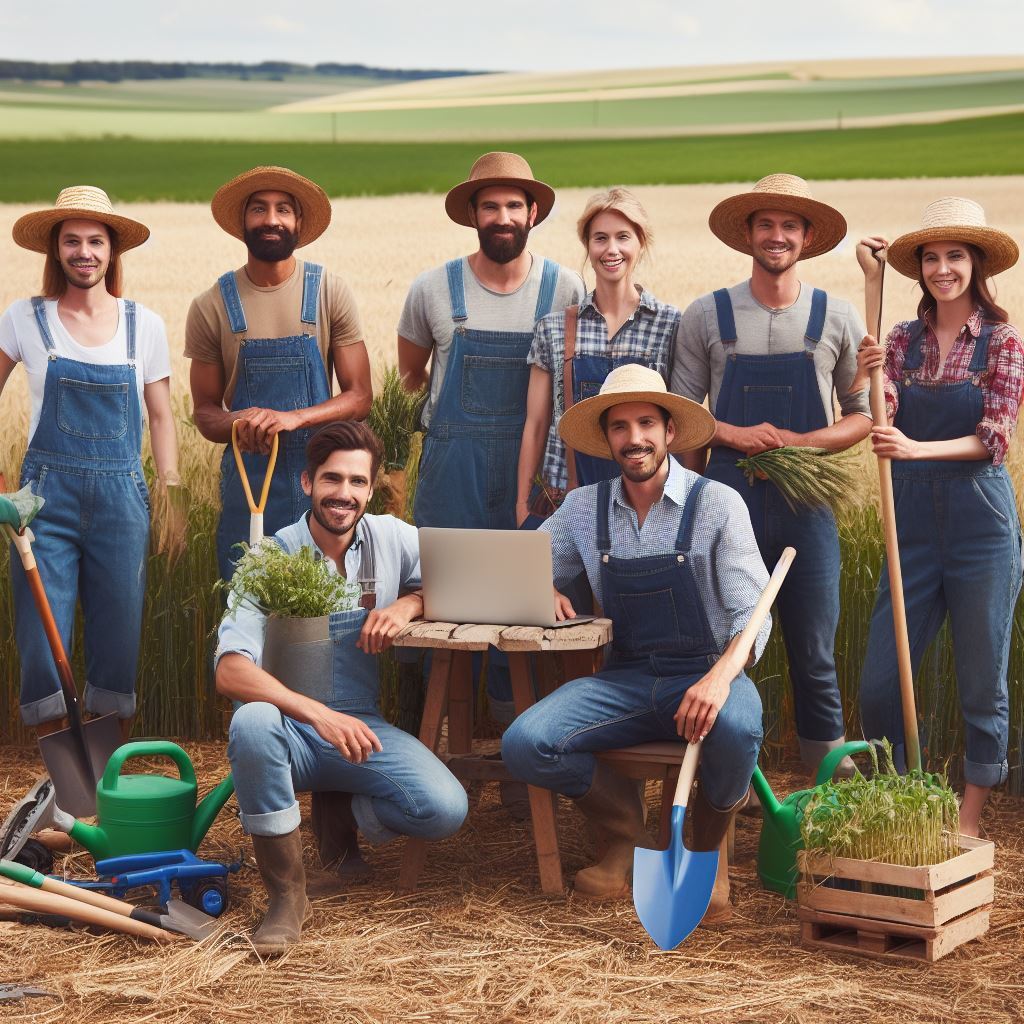Introduction
Precision coding can revolutionize USA agriculture by enhancing efficiency and productivity, optimizing resource use, and improving crop yields.
In a rapidly evolving world, technology integrates into every industry, including agriculture. Precision coding, or precision agriculture, is cutting-edge technology with transformative potential.
It benefits agriculture greatly. Using advanced sensors, GPS, and data analytics, farmers optimize resource usage, saving costs, reducing waste, and promoting sustainability.
Precision coding excels at increasing crop yields. Monitoring and analyzing data enable farmers to meet specific crop needs for healthier plants, quality produce, and higher profitability.
Imagine a world where every plot of land is optimized. Real-time soil and climate data guide precise actions, resulting in bountiful harvests and improved food production.
Picture a future where farmers embrace digital innovation, solving global food challenges through precision coding. Advanced tech unlocks vast possibilities.
Explore how precision coding transforms agriculture, from planting to harvesting, addressing challenges and offering exciting opportunities. Join the agricultural revolution!
Understanding Precision Coding
Define precision coding in the context of agriculture
- Precision coding refers to the use of advanced technology and data analysis to optimize agricultural practices.
- It involves the precise application of resources such as water, fertilizers, and pesticides based on specific needs.
- By using precision coding, farmers can maximize crop yield while minimizing waste and environmental impact.
- It is a key component of modern agriculture that aims to revolutionize the way we grow and produce food.
- Through precision coding, farmers can achieve greater efficiency, cost-effectiveness, and sustainability.
Explain how precision coding utilizes technology and data analysis
- Precision coding relies heavily on technologies like GPS, sensors, and drones to collect data about the agricultural field.
- These technologies gather information on soil conditions, moisture levels, temperature, and other relevant factors.
- The collected data is then analyzed to identify patterns, trends, and specific needs of the crops.
- With this information, farmers can make data-driven decisions on how to allocate resources effectively.
- For example, if a particular area has higher moisture content, precision coding can adjust irrigation systems accordingly.
Highlight the role of artificial intelligence and machine learning in precision coding
- Artificial intelligence (AI) and machine learning (ML) play a crucial role in precision coding.
- AI algorithms analyze the collected data and make predictions and recommendations based on patterns and historical data.
- ML models can identify disease outbreaks, nutrient deficiencies, and pest infestations at an early stage.
- These models help farmers take prompt action to prevent or mitigate potential crop damage.
- AI and ML enable automated processes such as autonomous vehicles and robotic systems for precision coding.
- Through constant learning and adaptation, AI and ML technologies optimize resource allocation and improve crop management.
In short, precision coding is a revolutionary approach in agriculture that maximizes crop yield while minimizing waste and environmental impact.
By utilizing advanced technologies, such as GPS, sensors, drones, and artificial intelligence, farmers can collect and analyze data to make data-driven decisions.
Precision coding allows for the precise application of resources based on specific needs, leading to greater efficiency, cost-effectiveness, and sustainability.
With the continuous advancement of technology and the integration of artificial intelligence and machine learning, precision coding is set to transform the agricultural industry and contribute to a more sustainable and productive future.
Read: Coding Salaries in Silicon Valley vs. Rest of the U.S.
The Current State of USA Agriculture
Challenges faced by traditional agriculture methods:
- Increasing demand for food due to population growth and changing dietary preferences.
- Dependency on unpredictable weather patterns affecting crop production.
- High labor costs and shortage of skilled farmers impacting productivity.
- Inefficient use of resources, such as water, fertilizers, and pesticides, leading to environmental concerns.
- Limited crop diversity and monoculture practices contributing to soil degradation and pest resistance.
Limitations and inefficiencies in current farming practices:
- Lack of real-time data and analytics for precise decision-making on crop management.
- Ineffective pest and disease control methods resulting in crop losses.
- Waste of resources through over-irrigation and excessive use of chemicals.
- Manual and labor-intensive processes leading to inefficiency and slow productivity.
- Inadequate traceability systems for food safety and quality assurance.
The need for technological advancements in agriculture:
- Precision coding can address the limitations and challenges faced by traditional farming methods.
- Advanced sensors, drones, and robotics enable real-time monitoring and data collection for optimal crop management.
- Machine learning algorithms and AI-powered systems can provide predictive analytics for disease and pest control.
- Automated irrigation systems based on soil moisture sensors optimize water usage and reduce wastage.
- Implementing precision coding can lead to higher yields, reduced resource consumption, and improved sustainability.
- Blockchain technology can enhance traceability, ensuring food safety and quality throughout the supply chain.
- Integration of precision coding with smart farming practices would boost productivity and profitability in the agriculture sector.
The agriculture industry in the USA needs technological advancements to address challenges and limitations in traditional farming methods. Precision coding can revolutionize agriculture.
Challenges include meeting food demand sustainably due to unpredictable weather and climate change. Traditional farming lacks real-time data, causing resource inefficiencies.
Precision coding uses sensors, drones, and robotics for precise monitoring and data collection. Machine learning and AI predict and control diseases, reducing chemical use.
Tech Consulting Tailored to Your Coding Journey
Get expert guidance in coding with a personalized consultation. Receive unique, actionable insights delivered in 1-3 business days.
Get StartedAutomated irrigation systems conserve water and reduce costs. Blockchain enhances traceability for food safety and quality.
Precision coding, combined with smart farming, increases yields, reduces resource consumption, and optimizes processes, overcoming traditional farming challenges.
Read: Negotiating Your Coding Salary: Tips and Strategies

Revolutionizing Agriculture with Precision Coding
Optimizing Agricultural Processes through Precision Coding
Precision coding has emerged as a game-changer in the field of agriculture, revolutionizing traditional farming methods.
Through the implementation of advanced coding techniques, various agricultural processes can be optimized, resulting in increased productivity and efficiency.
Applications of Precision Coding in Farming
- Precision Planting and Seeding: Precision coding allows farmers to accurately determine the optimal time and depth for planting seeds, maximizing harvest yields.
- Automated Weed and Pest Control: Through precision coding, farmers can develop automated systems that identify and eliminate weeds and pests, reducing the need for manual labor and chemical interventions.
- Efficient Irrigation Systems: Precision coding enables the development of smart irrigation systems that deliver water directly to the crops’ root zones, minimizing water wastage and enhancing water-use efficiency.
- Crop Monitoring and Disease Detection: Utilizing precision coding, farmers can implement sensors and drones that monitor crop health, detect diseases, and provide timely interventions, preventing the spread of infections and ensuring improved crop quality.
Real-World Examples of Precision Coding Success Stories in Agriculture
Precision coding transforms agriculture, showcased by success stories:
In Iowa, custom-coded systems increased corn yield by 20%, using 15% less seed, boosting profits, and reducing waste.
California saw a 90% herbicide reduction with precision-coded robots for weed control in strawberries.
Texas employed precision-coded irrigation, reducing water usage by 30% and promoting optimal crop growth.
Australia used coding to monitor vineyard health with drones, preventing crop loss and maintaining quality produce.
Precision coding optimizes farming processes for productivity, efficiency, and sustainability. It offers vast opportunities for agriculture’s future.
Read: Minecraft and JavaScript: What You Need to Know
Benefits of Precision Coding in Agriculture
Enhancing productivity and crop yields
Precision coding in agriculture revolutionizes the way farmers work, providing numerous benefits. One of the key advantages is enhanced productivity and increased crop yields.
By accurately coding and programming automated machinery, farmers can ensure that each plant receives the precise amount of water, nutrients, and care it needs.
Build Your Vision, Perfectly Tailored
Get a custom-built website or application that matches your vision and needs. Stand out from the crowd with a solution designed just for you—professional, scalable, and seamless.
Get StartedThis targeted approach to cultivation eliminates waste and maximizes the potential of each crop, resulting in higher productivity and improved yields.
Reducing environmental impact through optimal resource utilization
Precision coding also plays a pivotal role in minimizing the environmental impact of agricultural practices.
By precisely controlling the application of fertilizers, pesticides, and other chemicals, farmers can avoid overuse, reducing pollution and protecting surrounding ecosystems.
Furthermore, accurate coding allows for optimized water usage, preventing excess water consumption and preserving this precious resource.
Ultimately, precision coding promotes sustainable farming practices and helps to conserve the environment for future generations.
Minimizing costs and optimizing economic sustainability
In addition to its environmental benefits, precision coding in agriculture offers significant economic advantages.
By using coded automation and precision technology, farmers can minimize costs associated with labor, fertilizers, and water.
Automated machinery and precise application methods reduce waste and ensure resources are used efficiently, leading to cost savings.
Furthermore, optimizing crop yields through precision coding improves economic sustainability, allowing farmers to maximize their profits and invest in the growth of their operations.
Improving food quality and safety
Precision coding has a direct impact on the quality and safety of the food we consume.
By accurately monitoring and measuring factors such as temperature, humidity, and nutrient levels, farmers can ensure that crops are grown under optimal conditions.
This results in higher-quality produce with enhanced nutritional content, taste, and appearance.
Furthermore, precision coding allows for stricter monitoring and control of potential contaminants, reducing the risk of foodborne illnesses and improving overall food safety.
Precision coding in agriculture brings transformative benefits to the industry.
Optimize Your Profile, Get Noticed
Make your resume and LinkedIn stand out to employers with a profile that highlights your technical skills and project experience. Elevate your career with a polished and professional presence.
Get NoticedBy enhancing productivity and crop yields, reducing environmental impact, minimizing costs, and improving food quality and safety, it enables sustainable and efficient farming practices.
The integration of advanced technologies and precise coding in agriculture will undoubtedly revolutionize the way we cultivate and produce food, ensuring a more prosperous and sustainable future for both farmers and consumers.
Challenges and Considerations
Address potential obstacles to implementing precision coding in agriculture
- Lack of awareness and understanding among farmers about the benefits of precision coding.
- Resistance to change and reluctance to adopt new technology.
- High initial costs associated with implementing precision coding systems.
- Challenges in integrating precision coding with existing farming practices.
- Need for tailored solutions to meet the specific needs of different agricultural sectors.
Discuss the need for adequate infrastructure, training, and resources
- Availability of high-speed internet and reliable connectivity in rural agricultural areas.
- Investment in developing and maintaining the necessary hardware and software infrastructure.
- Training programs to upskill farmers and agricultural workers in precision coding techniques.
- Access to technical support and troubleshooting services for precision coding systems.
- Allocation of sufficient financial resources for research and development in precision coding technology.
Highlight the importance of data privacy and security
- Protection of sensitive farm data, such as crop yield, soil composition, and weather patterns.
- Adherence to strict data privacy regulations and guidelines to maintain farmers’ trust.
- Implementation of robust cybersecurity measures to safeguard against data breaches and cyberattacks.
- Establishment of clear protocols for data sharing and ownership within the agricultural industry.
- Educating farmers about the potential risks and benefits of sharing their data for research purposes.
Implementing precision coding in agriculture is not without its challenges and considerations.
Addressing these obstacles effectively is crucial for the widespread adoption and success of precision coding technology in the farming sector.
- Educate farmers about precision coding benefits: improved efficiency, higher yields, and cost savings to boost adoption.
- Alleviate resistance by providing training and support for transitioning from traditional farming to precision coding.
- Government subsidies can offset high initial costs, promoting precision coding adoption among farmers.
- Tailored, adaptable solutions ease integration of precision coding with existing farming practices.
- Ensure rural infrastructure, high-speed internet, and reliable connectivity for precision coding system functionality.
- Vital training programs and technical support are essential for farmers to effectively operate and maintain precision coding technology.
- Prioritize data privacy and security, adhering to regulations and implementing robust cybersecurity measures in precision coding.
Precision coding can revolutionize US agriculture. Addressing obstacles, ensuring infrastructure, and prioritizing data security integrate it effectively for productivity, sustainability, and profitability.
Read: Entry-Level Coding Salaries: What to Expect in 2024
Conclusion
In this blog post, we discussed the potential of precision coding to revolutionize agriculture in the USA. We explored how this technology can enhance efficiency, increase yields, and reduce costs.
Precision coding has the power to transform farming practices and bring about a new era of sustainability and productivity in the agricultural sector.
By leveraging data and advanced algorithms, farmers can make informed decisions and optimize their operations.
It is crucial for farmers and stakeholders in the agricultural industry to embrace and adopt precision coding technologies.
By doing so, they can unlock the full potential of this innovative approach and contribute to the advancement of agriculture in the USA.
Take action now and explore the possibilities of precision coding in agriculture. Investigate the various solutions available, attend workshops, and collaborate with experts in the field.
By adopting precision coding, you can play a part in revolutionizing agriculture and ensuring a brighter future for farmers and our food supply.




